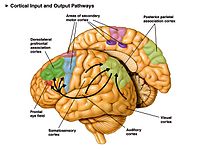
Photo from wikipedia
The execution of coordinated hand movements requires complex interactions between premotor and primary motor areas in the two hemispheres. The supplementary motor area (SMA) is involved in movement preparation and… Click to show full abstract
The execution of coordinated hand movements requires complex interactions between premotor and primary motor areas in the two hemispheres. The supplementary motor area (SMA) is involved in movement preparation and bimanual coordination. How the SMA controls bimanual coordination remains unclear, although there is evidence suggesting that the SMA could modulate interhemispheric interactions. With a delayed‐response task, we investigated interhemispheric interactions underlying normal movement preparation and the role of the SMA in these interactions during the delay period of unimanual or bimanual hand movements. We used functional MRI and transcranial magnetic stimulation in 22 healthy volunteers (HVs), and then in two models of SMA dysfunction: (a) in the same group of HVs after transient disruption of the right SMA proper by continuous transcranial magnetic theta‐burst stimulation; (b) in a group of 22 patients with congenital mirror movements (CMM), whose inability to produce asymmetric hand movements is associated with SMA dysfunction. In HVs, interhemispheric connectivity during the delay period was modulated according to whether or not hand coordination was required for the forthcoming movement. In HVs following SMA disruption and in CMM patients, interhemispheric connectivity was modified during the delay period and the interhemispheric inhibition was decreased. Using two models of SMA dysfunction, we showed that the SMA modulates interhemispheric interactions during movement preparation. This unveils a new role for the SMA and highlights its importance in coordinated movement preparation.
Journal Title: Human Brain Mapping
Year Published: 2019
Link to full text (if available)
Share on Social Media: Sign Up to like & get
recommendations!